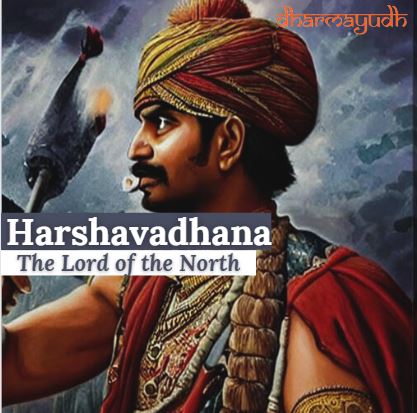The Pushyabhutis of Thanesar emerged as a strong and dominant power in the early medieval history of India. Initially, they established themselves at Thanesar, and later under their able kings they gradually expanded their region.
The most important monarch of the Pushyabhutis was King Harsha Vardhana who is also known as the Lord of the North. He was a tolerant king who was also a great patron of art and culture.

Due to his generous nature and aggressive military campaigns, he is entitled to many names such as Siladitya (mentioned in the writings of Chinese pilgrim Hsuan Tsang), Sakalauttarapathanatha (Lord of the North) given by the Chalukyan king Pulkesin II.
His career is full of military campaigns and in this article, we will shed light on the glorious reign of Harsha Vardhana.
Content
Origin of the Pushyabhutis
The Gupta Empire was weakened by the Hunnic invasions and after its downfall, many regional powers emerged in northern India.
However, nothing can be said accurately about the early history of the Pushyabhutis. It is believed that the first three kings of this dynasty might have adopted the titles like Maharaja and most probably they were the feudatory rulers of the Guptas.
Historical sources like Harshacharita authored by Banabhatta and writings of pilgrims like Hsuan Tsang mentioned Prabhakar Vardhana as the real founder of this dynasty.
Prabhakar Vardhana was the father of Harsha Vardhana and the fourth king of the Pushyabhutis. According to Banabhatta Prabhakar Vardhana was a great military leader who had fought lethal campaigns against the Huns, and several other neighboring kingdoms like Sindhu, Gandhara, etc.
He also made a martial alliance with the Maukharis of Kannauj. King Prabhakar married his daughter Rajyashri to Grahavarman the prince of Kannauj.
Harsha Vardhana: The Lord of the North
Harsha Vardhan is remembered for his visionary skills which made him the champion of the north. He was a great military leader, a staunch follower of Shavism, and a huge patron of art.
Furthermore, he was also a great scholar and writer. During his reign, he authored three important dramas namely Nagananda, Ratnavali, and the famous Priyadarshika.

According to Banabhatta Harsha was also a great flute player. With his leadership qualities, military governance, and diplomatic ties Harsha extended the control of the Pushyabhutis over regions like Punjab, Kannauj, Mithila, Orissa, etc which made him the master of north India.
Hsuan Tsang described Harsha Vardhan as an energetic monarch whose life was filled with wars and dedicated to his people. According to him, Harsha had a huge standing army comprising of immense elephants and cavalry forces.
In the year 643 CE Hsuan Tsang mentioned that Harsha Vardhana organized a grand assembly at Kannauj which was attended by different religious scholars of Buddhism, Jainism, and Hinduism.
Military Campaigns of Harsha Vardhana
After the death of Prabhakar Vardhana his elder son Rajya Vardhana ascended the throne of the Pushyabhutis. However, things changed dramatically when the news about the death of King Grahavarman who was killed by Malava (Malwa) came from Kannauj.
Furthermore, the Malwa king also imprisoned Rajyashri the daughter of King Prabhakar, and was eyeing an invasion of Thanesar.
To stop the hordes of the enemy king the newly appointed king i.e. Rajya Vardhana marched his troops to face the brunt of the Malwas. At this crucial juncture, he gave the charge of his empire to his younger brother Harsha Vardhana.
Rajya Vardhana fought audaciously and defeated the Malavas but was ultimately killed by Gauda king Shashanka by treachery.
Hearing the story of his elder brother who despite crushing his enemy attained martyrdom Harsha ascended the throne of the Pushyabhuti kingdom.
Harsha was only 16 when he became the king and wanted to avenge his brother’s death by crushing the kingdom of the Guada. He launched a successful campaign against Shashanka and extended his influence over the parts of Kongoda in Orissa.
According to Hsuan Tsang Harsha launched successive campaigns in the east and took the regions of Orissa, Magadha, Bengal, and Kongoda. He also took control over Punjab and central India.
Furthermore, the region of Nepal is believed to have accepted Harsha’s rule. The region of Kashmir also paid tribute to the Pushyabhutis.
In eastern India Bhaskaravarman, the king of the Kamrupa kingdom and Dhruvabhata accepted the suzerainty of the Harsha. The most famous military expedition of Harsha was against the Western Chalukyas of Badami. Harsha Vardhana wanted to cross the Narmada region in order to expand the empire’s boundary.
However, Chalukyan king Pulkesin II proved to be a tough opponent for Harsha. Pulkesin II defeated the Pushyabhuti king and stopped the advance of the latter to cross the Narmada.
The great career of this monarch of North India finally ended in the year 647 CE. After his death, the empire became weak and was later overthrown by kingdoms like Gurjara Pratiharas and Rajput kingdoms.
LIKE WHAT WE ARE DOING? DONATE TO DHARMAYUDH
If you support what we are doing and would like to contribute to help us grow and reach more Indians to teach them more about such forgotten historic Indian Heroes and stories, please consider donating any amount. It will help us grow.

